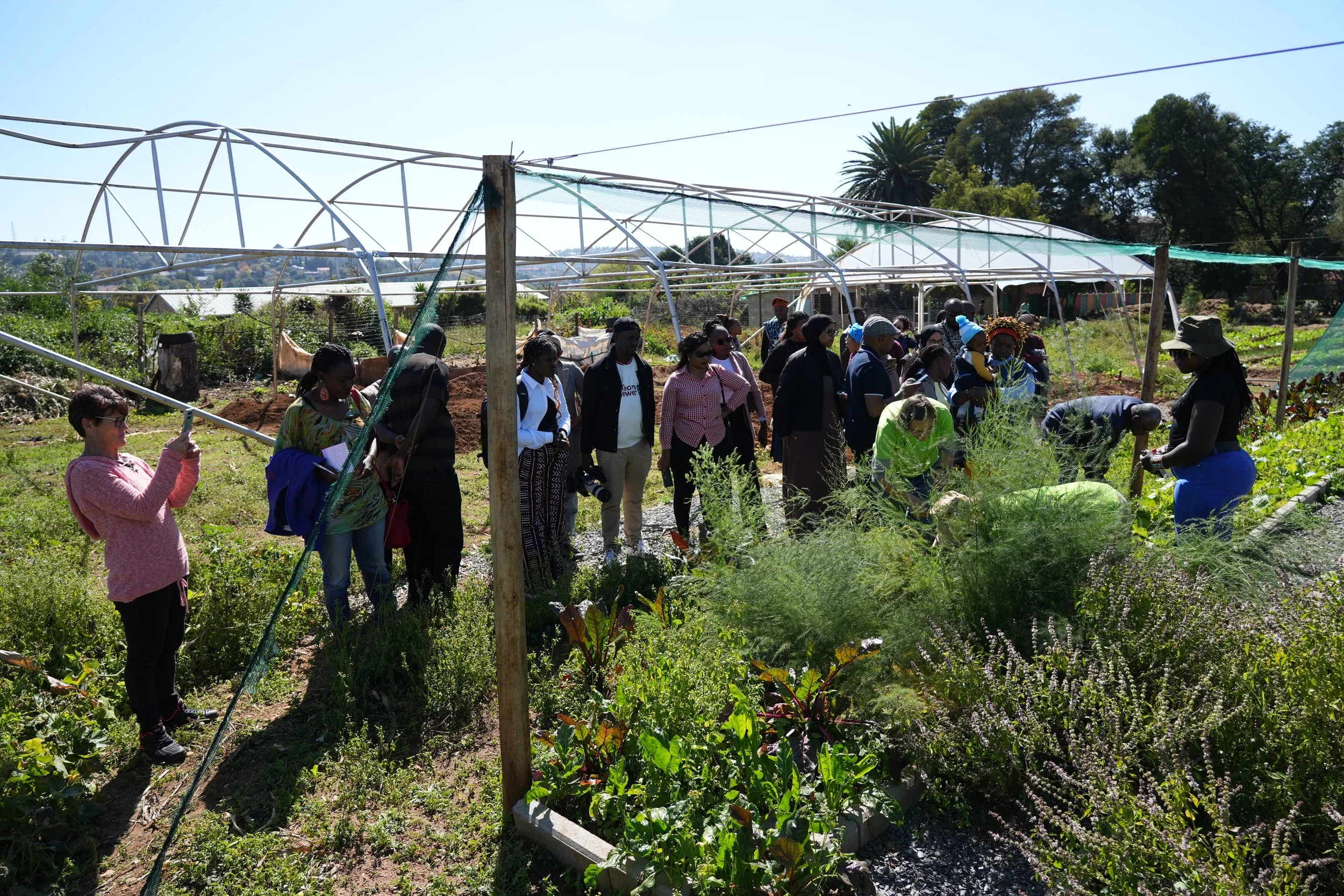Gardens of Grace: Agricultural adaptation in action
BY FREDRICK OTIENO
It’s a warm and glorious midmorning when our delegation arrives at the luxuriant farm in Newlands on the outskirts of Johannesburg. When she comes to meet us, Mama Judy’s fingers are already soaked in black earth. While it’s only 10 AM, activities at the farm are in high gear.
We are members of the Pan African Coalition for Adaptation and Resilience (PACAR), visiting the farm to see adaptation in action. Without much ado, Mama Judy takes us on a tour of the farm that lies on a one-hectare municipal land.
From the outset, the farmer attempts to answer the question on our minds: how differently should Africa farm to feed its people amidst a changing climate? She summarises it with astonishing ease, saying:
“Climate-compatible agriculture is the answer. With agricultural adaptation, we can feed our people, support rural economies and supply culturally acceptable nutrition.’’
Listening to this sociable farmer is to tap into a deep and fulfilling well of knowledge on agroecological practices, the philosophy employed by Gardens of Grace.
On this group farm, a diversity of food crops and animals combine into a striking tapestry of abundance, beauty and hope. There are vegetables of all kinds, chickens and goats. The lushness of the farm and winsome smiles on the faces of the workers are evidence of the symbiotic interaction...
At a glance: Gardens of Grace
Gardens of grace is an “initiative for life beyond subsistence,” as the women custodians of the farm proudly describe it. But the plot looks nothing like the wild it was three years ago. The women group turned it from a wasteland overgrown with invasive plants to the model agroecological setup it is now.
The original idea was to turn the badlands into productive use, ward off pests and reduce crime in the area. Then the work started, with support from Gender CC and other organisations. Brushes and thorns gave way to fruit trees. Where criminals lounged, pomegranates, peaches, apricots and plums cropped up.
The farm utilises locally available resources to produce an assortment of vegetables. Spinach, Chinese cabbage, mustard leaf and chomolia, amaranth and pumpkins flourish in the farm. The farm supplies its green produce to local vendors.
What’s more, the farm is an herbal sanctuary. Borage, artemisia and moringa are among the medicinal plants that thrive here, as testament to the crop diversity agroecology supports.
Three years later, Gardens of Grace is a case study of land reclamation, food security and sustainable livelihoods.
The agroecology and industrial agriculture divide
Africa’s population has grown fivefold in the last four decades to the current 1.5 billion people. By 2050, the continent will be home to 2.5 billion people. An additional 1 billion people in two decades means more mouths to feed.
Proponents of industrial agriculture argue that large-scale monoculture, featuring intensive use of agrochemicals, is the only certain means to feed Africa’s population exploding population.
Agroecologists like Mama Judy, however, disagree. To them, industrial farming only perpetuates the dominance of a handful of players in the global agrochemical industry.
She warns that there are more dangers of growing food through industrial means. Agrochemical and seed giants tend to overrun smallholder farmers by disregarding food and seed sovereignty, cultural acceptability of food and nutritional self-sufficiency.
Monocropping, she explains, costs farmers the benefits of mixed cropping. By intercropping, some species repel pests, provide shade and improve the soil’s nitrogen content, she adds.
A case for agroecology
As the impacts of climate change escalate, critical resources for agriculture are diminishing. Rainfall has become unpredictable. Soil is less fertile. The average temperature has soared. Crop pests and diseases are now more prevalent.
All these factors call for cost-effective interventions to ensure a stable supply of culturally acceptable but also nutritionally dense foods.
To that end, adaptation becomes vital to sustain food farming. This includes resilience-building innovations that promote sustainable farming.
Across most African communities, families own small pieces of land, typically less than two hectares. This makes farm mechanisation impractical and cost ineffective. Equally, overreliance on synthetic fertilisers changes soil health over time, making it difficult to grow food without them.
At the Garden of Grace, the application of nature-based solutions is evident. The farm uses natural decomposers to make compost, for instance. This manure is made using locally sourced plant-based organic matter.
Chicken on the farm help with weed control and feed on pests such as aphids. Their droppings provide additional organic manure to enhance soil fertility.
Can agroecology feed Africa?
Mama Judy, like her colleagues, believes so. To her, agroecology not only supports local food systems but boosts resilience against climate change as well.
Even so, questions persist on its suitability for the continent’s food and nutritional needs.
Experts, however, argue that agroecology practices are scalable; they can be tailored to meet the specific needs of farmers.
The principle of agroecology, experts insist, isn’t to consign farmers to perpetual small-scale production. Rather, it’s to ensure they have control of their food systems, live in harmony with nature and build the resilience of their farms and families. Both smallholder and large-scale farmers ensure that Africa’s food and nutritional security are met.
Drip irrigation, composting, mixed cropping, agroforestry, mulching and biological pest control are all agroecological practices. These are scalable.
If land were consolidated to free up more land for agricultural production, it would still be possible to expand and practice agroecology in large-scale food production.
Thankfully, Africa has a young, energetic youth population. Even without intense mechanisation, this human capital can provide labour on farms, thus creating employment.
So, what does adaptation to climate change look like in real life?
This is a common question that doesn’t have a specific answer because adaptation encompasses a wide range of action areas. Interventions depend on where and how frontline communities live.
Showcasing successful adaptation and resilience building actions by communities, such as the women of Garden of Grace, is important. It builds a strong case for adaptation in Africa.
As we depart from the Garden of Grace, the atmosphere is one of deep reflection. For many of us, the role of agroecology in climate adaptation has never been clearer.
Fredrick Otieno is a Programs Officer at Power Shift Africa



